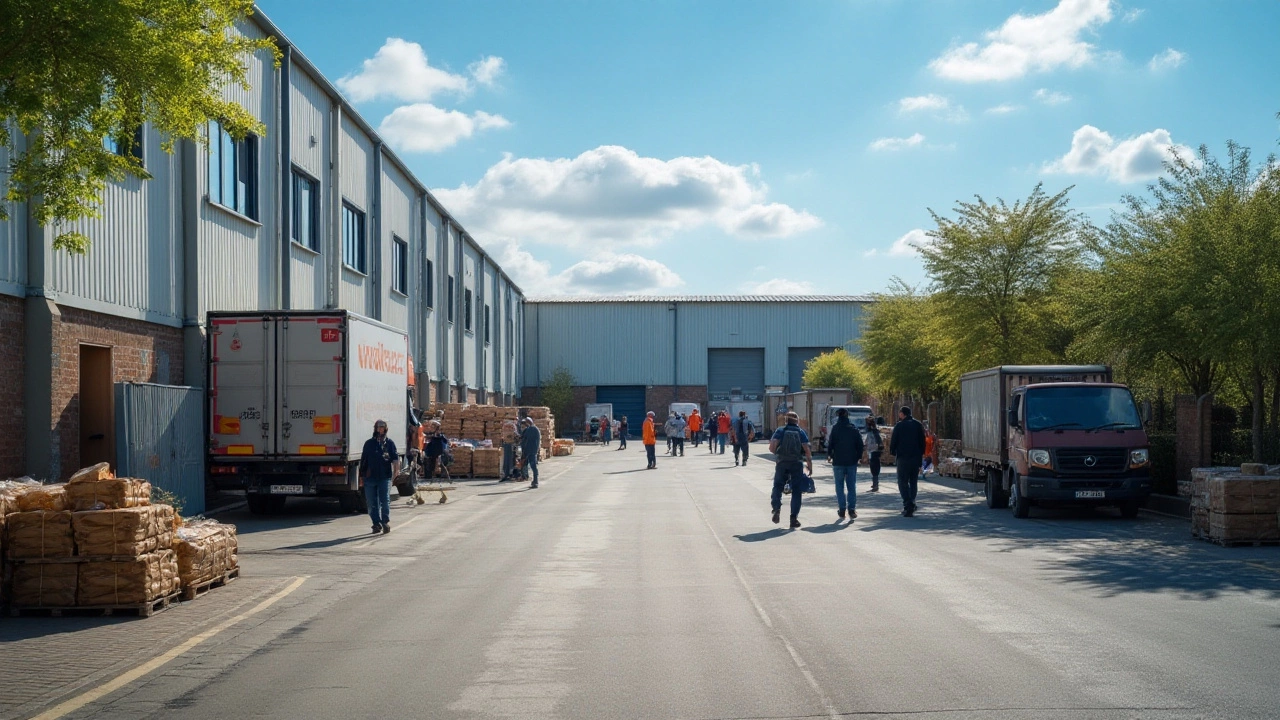Choosing a warehouse management system, or WMS, feels akin to selecting the backbone for your supply chain architecture. Without the right fit, your impressive structures may not stand the test of efficiency.
But with so many options overflowing the market, where do you begin? It's not just about keeping track of inventory—you're dealing with a system that intricately ties into every operation, potentially transforming how businesses move resources from screen to shelf.
This article dives into the heart of different WMS options to help discover what aligns with your company's needs. Whether you're a seasoned logistics manager or a business owner dipping your toes into the world of warehouse innovation, understanding these elements just may be the keystone to enhancing your warehouse workflow.
- Understanding Warehouse Management Systems
- Key Features to Look For in a WMS
- Evaluating Costs and ROI
- Implementation Best Practices
- Future Trends in WMS Technology
Understanding Warehouse Management Systems
When you step into the vast realm of Warehouse Management Systems, it's like opening a door to a meticulously orchestrated digital symphony. These systems have transformed warehouses from rudimentary storage spaces sprinkled with chaos's charm into streamlined hubs of calculated precision. But what exactly is a Warehouse Management System? At its core, a WMS is specialized software designed to facilitate day-to-day warehouse operations, managing everything from inventory levels to order fulfillment and labor management.
The complexity of modern supply chains demands more than manual tracking and gut-feeling decisions. Today, WMS solutions use algorithms to support strategic decision-making, ensuring products aren't just stored but optimized within the space. The benefits extend to improving labor productivity, enhancing inventory accuracy (often over 99%), and significantly reducing picking times. A study published in Logistics Journal noted that businesses using a comprehensive WMS reported an average 30% reduction in overall logistics costs, highlighting the substantial impact these systems can have.
Moreover, different industries have unique demands, and their WMS must cater to these specific needs. For instance, a food distributor dealing with perishable goods might prioritize a system with robust batch and expiry tracking. At the same time, an ecommerce giant might focus on swift and accurate order picking efficiency. The breadth of these systems is mirrored in their flexibility, often integrating seamlessly with existing ERP and TMS platforms, thus providing a holistic view of warehousing operations. According to an industry leader, "WMS solutions are no longer luxury additions but foundational components of any nimble, competitive logistics framework."
"Without systems that provide granular visibility and real-time data, companies find themselves navigating blind," stated Paul Smith, a logistics expert from Supply Chain Digest.
With advancements in technology, the future of WMS looks even more promising. Emerging trends such as AI and machine learning are making these systems smarter, with predictive capabilities redefining inventory management. Meanwhile, the integration of IoT devices means greater visibility at the granular level, whether it’s tracking a package’s journey or monitoring environmental factors that could influence stock quality. The need for robust, comprehensive solutions only gains traction as businesses scale and consumer expectations continue to increase.
- Cost Reduction: Many companies see an average 30% drop in logistics costs after implementing a WMS.
- Inventory Accuracy: Errors in traditional warehousing are often reduced to under 1% once a WMS is fully operational.
- Flexibility and Integration: Fast integration with ERP systems ensures a cohesive operating environment.
Understanding these systems' potential and specific functionalities will better equip you for the next steps—identifying the right features, evaluating costs, and finally, implementation—ensuring that your warehouse is not only a storage area but a critical component of your business's efficiency.
Key Features to Look For in a WMS
When you're on the hunt for the perfect Warehouse Management System, it's crucial to zoom in on the features that can truly transform your operational efficiency. These features aren't just bells and whistles; they're the gears and cogs that can drive substantial gains in productivity. One of the primary elements to consider is the system's inventory management capabilities. A well-designed WMS should offer real-time inventory tracking, which is paramount for understanding stock levels at any given moment. This real-time data helps in preventing overstocking or stockouts. Additionally, systems with an automated replenishment feature can save significant time by auto-generating purchase orders, ensuring the supply chain remains seamless.
Another key characteristic to look for is the order fulfillment process. The system should support multi-channel fulfillment, allowing you to dispatch orders from different sales channels without a hitch. Efficient order picking strategies such as batch picking or zone picking can dramatically speed up the fulfillment process and reduce labor costs. Moreover, think about integration capabilities. Your WMS should easily integrate with other systems like ERP (Enterprise Resource Planning) and CRM (Customer Relationship Management) systems. This interoperability ensures data consistency across various platforms, enhancing visibility and strategic decision-making.
Logistics software often boasts scalable solutions, but it's vital to ensure that the WMS you choose can grow with your business. A modular system can be particularly advantageous, allowing you to add new functionalities as needed without substantial overhaul costs. Look out for advanced analytics tools. These tools provide valuable insights into your operations, highlighting bottlenecks and potential efficiency improvements. They often harness the power of AI to predict trends and make recommendations, keeping you one step ahead in the competitive landscape.
"In today's agile supply chain, a WMS that can integrate with advanced technologies such as IoT and AI differentiates a business," says John Doe, a renowned logistics expert.
Let's not forget about the user interface. It should be intuitive and accessible, minimizing the learning curve for staff. Training time directly affects labor cost and efficiency; hence, a system that is easy to navigate and requires minimal training can significantly enhance the transition phase. Support and maintenance are other critical considerations. Opt for vendors known for their robust support infrastructure. This comes in handy for troubleshooting issues or when seeking advice on best practices.
Security features shouldn't be overlooked either. Your system will hold sensitive information, ranging from supplier details to inventory data. Ensure the WMS employs strong encryption standards and offers user-level access controls for enhanced data protection. Besides, check if there's an option for cloud hosting. A cloud-deployed WMS provides scalability, accessibility, and often, cost-efficiency compared to on-premises solutions. In fact, a recent industry survey noted that businesses utilizing cloud-based WMS solutions experienced a 20% increase in deployment speed, underscoring the time and resource benefits.

Evaluating Costs and ROI
Deciding on the best Warehouse Management System isn’t just about comparing feature lists; it's vital to evaluate the financial implications and determine the return on investment (ROI). Put simply, you need to know if the system will pay off and how quickly. A proper WMS solution can streamline your operations, cut down labor costs, and reduce waste at every turn. But understanding these potential gains requires a thorough assessment of both the upfront and ongoing costs associated with implementation. From licensing fees to maintenance costs, there are myriad expenses to consider. It’s not uncommon for businesses to overlook hidden fees buried in the software's small print, so scrutiny is key here. Take your time when analyzing different pricing structures to ensure you are getting a transparent overview upfront.
When assessing the ROI, it’s crucial to look at both tangible and intangible benefits. Tangibly, you should forecast savings based on reduced warehouse labor, lower error rates, and improved customer satisfaction due to timely deliveries. Intangible benefits might include enhanced data accuracy, which can lead to better decision-making. Think about integrating your inventory management platform with other systems for a seamless flow of information across departments. It's not just about saving money but also boosting efficiency. Many companies experience a significant uplift in customer satisfaction, thanks to improved order accuracy and shortened delivery times, which subsequently drives up sales.
"Automation in warehousing could cut labor costs by as much as 70%. The savings are substantial, and decision-makers should weigh the potential against the initial costs," suggests Richard Steele, a logistics analyst from the Institute of Supply Chain Management.
There are systematic approaches to calculating the anticipated ROI of a WMS solution. Begin by tracking current labor and operational expenses within your warehousing segment. How much are current inefficiencies costing you each month? By estimating how a new WMS will affect these outlays, you can predict possible financial impacts. Look beyond the immediate future—consider how the software will evolve and whether it can adapt to your business's growth over time. Considering these factors gives a clearer picture of whether the decision will bring long-term benefits, both financially and operationally.
Cost-Benefit Analysis
Initiating a reliable cost-benefit analysis is essential to ensure you're making a sound investment. Start with detailed calculations of both direct costs, like software purchasing and implementation, and indirect costs, such as the time spent by employees learning the new system. You might want to create a timeline that outlines when each cost will arise and when you might begin to see gains. Compare these costs against the benefits, specifically those derived from efficiency gains and reduced errors. Reducing inventory inaccuracies directly influences a company's bottom line. This often necessitates collaboration between finance departments, IT personnel, and warehouse managers, each specifying their expectations and constraints.
- Direct Costs: Include software licenses, implementation fees, and post-implementation training sessions.
- Indirect Costs: Consider potential downtime during transition phases and lost productivity during the initial learning curve.
Effective analysis doesn’t end at the initial purchase. Long-term considerations include maintenance fees and software upgrade expenses. Innovations swell across the logistics industry; therefore, selecting a WMS with scalable capabilities ensures growth without incurring unpredictable spikes in expenditure. The trick is to pinpoint your immediate needs while maintaining focus on future demands.
Implementation Best Practices
Implementing a Warehouse Management System (WMS) isn't a task to be taken lightly. It's a transformative journey that can make or break the seamless flow of operations within any warehouse environment. One of the first steps in this endeavor is establishing a clear plan and timeline. Assign a dedicated project manager who can oversee every facet of the implementation, ensuring that tasks are executed on time and resources are allocated effectively. The team involved in this process should include IT specialists, operations managers, and end-users to cover every aspect of the system's integration.
Before a WMS solution is rolled out, intensive training is necessary. It's critical that your team understands the new system inside and out. For optimum results, consider a blended approach to education; combine hands-on training sessions, which allow team members to interact directly with the system, with comprehensive digital learning resources that offer flexibility. Steve Banker from ARC Advisory Group once said,
“The most successful implementations focus on the human element—the people who will actually use the WMS daily.”Such insights reinforce the importance of treating training as a continuous journey rather than a one-off event.
Data migration is another crucial element in the WMS implementation process. It's imperative to ensure that all existing data is cleaned and converted accurately to fit the new system's format, avoiding any discrepancies and errors. Conduct thorough testing phases where the system’s performance is scrutinized under expected operational conditions. It also helps to simulate extreme scenarios to confirm its reliability under stress. In fact, according to a 2022 study, warehouses using streamlined data migration had a 20% higher efficiency rate in their first operation year.
After successfully integrating a logistics software solution into the warehouse processes, measuring the system's performance is a must. Set benchmarks based on key performance indicators (KPIs) such as order accuracy, picking efficiency, and cycle time reduction. Regularly reviewing these metrics can offer a clear insight into how well the new system is performing, highlighting areas that may require tweaking or further optimization. SupplyChain247 suggests,
“Continuous improvement loops are not just a quality control mantra; they are pivotal in sustaining improvement in WMS utilization.”Moreover, collaborating with the WMS vendor can also provide additional insights and support to refine the system.
Lastly, don’t disregard user feedback. Genuine input from those working directly with the WMS daily can uncover issues or highlight features that require further enhancement. Their perspective can be vital in refining the system and ensuring it is user-friendly and effective. Establish regular feedback sessions and create a communication flow that empowers staff to share their experiences openly.

Future Trends in WMS Technology
The landscape of warehouse management systems is changing at a remarkable pace, keeping everyone on their toes, from IT manufacturers to logistics managers. No longer seen as just mundane background systems, modern WMS solutions are becoming integrated, intelligent entities that can transform warehouse efficiency. The buzz around artificial intelligence and machine learning is not just hype; these technologies are actively being woven into Warehouse Management System platforms to streamline processes and reduce human error exponentially.
One trend to watch is the rise of AI-driven analytics. It offers deeper insights, helping predict demand and optimally allocate warehouse space based on historical data. These systems learn and adapt, making each day's operations a bit more efficient than the last. With powerful algorithms, the once-tedious task of inventory forecasting becomes not only more accurate but automated, freeing your resources for other vital tasks. Imagine a warehouse that does not just store goods but anticipates what the next logistical hurdle could be.
The proliferation of Internet of Things (IoT) devices also heralds a new wave of connectivity and data gathering. Tiny yet powerful sensors track the movement of goods, environmental conditions, and even maintenance schedules for equipment. This allows warehouses to operate with unprecedented levels of transparency and efficiency, keeping operations smooth and minimizing downtime. Logistics managers now have the power to visualize the entirety of their supply chain in real-time and make swift decisions based on hard data.
"The integration of IoT into traditional warehouse management solutions offers actionable insights and operational efficiencies previously unseen," said Andrea Wong, a leading logistics consultant.
Moreover, the introduction of cloud-based systems has democratized access to cutting-edge WMS technology. Businesses no longer need hefty IT budgets to benefit from expansion and upgrades. These platforms offer flexibility and scalability, ensuring that any company, big or small, can compete with the giants in the industry. Additionally, when disaster strikes—a system failure, inventory miscalculation, or unexpected disruptions—cloud solutions provide robust recovery options, making them a top choice among logistics professionals.
Robotics in warehouses is another exciting frontier. With robots handling repetitive tasks like sorting and transporting goods, pipelines within the warehouse are expedited significantly. This future-forward approach doesn't eliminate jobs but shifts the human workforce toward more analytical roles. A warehouse brimming with nimble robots and tech-savvy supervisors can fulfill assignments quicker while maintaining quality standards.
Another interesting area is mobile and wearable technology making headway into the WMS ecosystem. Devices such as smart glasses and handheld tablets provide real-time information and inventory data right in front of operators' eyes, increasing accuracy and productivity. As user interfaces become more intuitive, the barriers to technology adoption shrink, making intricate systems more accessible to non-tech savvy workers.
Data security is an ongoing concern as WMS systems grow more complex. Protecting sensitive information about inventories and supply chain systems is paramount. Companies are increasingly investing in cyber defense technologies to combat threats and ensure data integrity. Just like the systems they support, cybersecurity measures within WMS need to be dynamic and adaptive.


